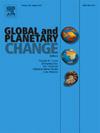The history of the El Niño–Southern Oscillation and sea surface salinity during 1376–1500 CE reconstructed by Porites coral δ18O from Huangyan Island, South China Sea
IF 4
1区 地球科学
Q1 GEOGRAPHY, PHYSICAL
引用次数: 0
Abstract
The El Niño–Southern Oscillation (ENSO) is the most influential climatic phenomenon affecting global ecosystems, water use, and agriculture on an interannual scale. However, limited instrumental records make it difficult to fully understand the characteristics of ENSO events. In this study, we used both monthly-resolved Porites coral δ18O records, i.e., living Porites corals of δ18O–HYDL4 (1992–2015) and subfossil Porites corals of δ18O–HYD3 (1376–1500 CE), from Huangyan Island in the South China Sea (SCS), to reconstruct the moderate intensity ENSO and sea surface salinity (SSS) during 1376–1500 CE. The results show that the SSS was higher but the frequency of moderate-to-high intensity ENSO events was lower than the present during 1376–1500 CE. ENSO activity was generally similar to or slightly lower than that of today, but it included several very strong ENSO events in the first substage (1376–1450 CE), while it was relatively quiet in the second substage (1451–1500 CE). More moderate-intensity ENSO events may have occurred in the relatively warm climate. The variation in coral δ18O was dominated by multiple factors in this region. SST, ENSO and the Pacific Decadal Oscillation (PDO) may be the dominant factors influencing the changes in coral δ18O at different timescales.
南海黄岩岛海泡石珊瑚δ18O重建的厄尔尼诺-南方涛动和公元1376-1500年期间海表盐度的历史
厄尔尼诺-南方涛动(ENSO)是影响全球生态系统、水资源利用和农业年际尺度的最有影响力的气候现象。然而,由于仪器记录有限,很难全面了解 ENSO 事件的特征。在本研究中,我们利用南海黄岩岛的月分辨波罗的海珊瑚δ18O记录,即活体波罗的海珊瑚δ18O-HYDL4(1992-2015年)和亚化石波罗的海珊瑚δ18O-HYD3(公元1376-1500年),重建了公元1376-1500年期间中等强度的ENSO和海表盐度(SSS)。结果表明,公元 1376-1500 年期间,SSS 较高,但中高强度 ENSO 事件的频率比现在低。厄尔尼诺/南方涛动活动总体上与现在相似或略低于现在,但在第一子阶段(西元 1376-1450 年)包括几次非常强烈的厄尔尼诺/南方涛动事件,而在第二子阶段(西元 1451-1500 年)则相对平静。在相对温暖的气候条件下,可能发生了更多强度适中的厄尔尼诺/南方涛动事件。该地区珊瑚 δ18O 的变化受多种因素的影响。在不同时间尺度上,海温、厄尔尼诺/南方涛动和太平洋十年涛动可能是影响珊瑚 δ18O 变化的主要因素。
本文章由计算机程序翻译,如有差异,请以英文原文为准。
求助全文
约1分钟内获得全文
求助全文
来源期刊

Global and Planetary Change
地学天文-地球科学综合
CiteScore
7.40
自引率
10.30%
发文量
226
审稿时长
63 days
期刊介绍:
The objective of the journal Global and Planetary Change is to provide a multi-disciplinary overview of the processes taking place in the Earth System and involved in planetary change over time. The journal focuses on records of the past and current state of the earth system, and future scenarios , and their link to global environmental change. Regional or process-oriented studies are welcome if they discuss global implications. Topics include, but are not limited to, changes in the dynamics and composition of the atmosphere, oceans and cryosphere, as well as climate change, sea level variation, observations/modelling of Earth processes from deep to (near-)surface and their coupling, global ecology, biogeography and the resilience/thresholds in ecosystems.
Key criteria for the consideration of manuscripts are (a) the relevance for the global scientific community and/or (b) the wider implications for global scale problems, preferably combined with (c) having a significance beyond a single discipline. A clear focus on key processes associated with planetary scale change is strongly encouraged.
Manuscripts can be submitted as either research contributions or as a review article. Every effort should be made towards the presentation of research outcomes in an understandable way for a broad readership.
 求助内容:
求助内容: 应助结果提醒方式:
应助结果提醒方式:


